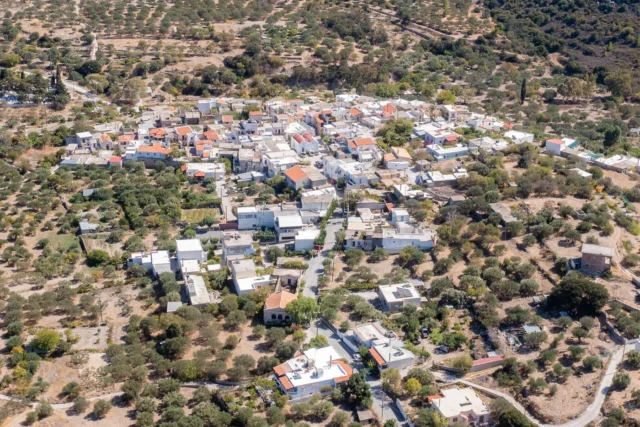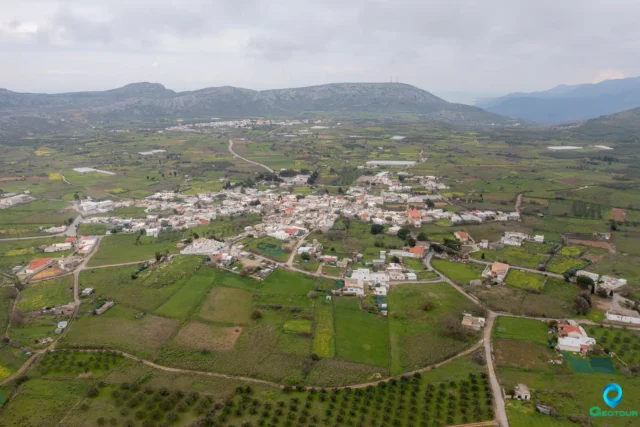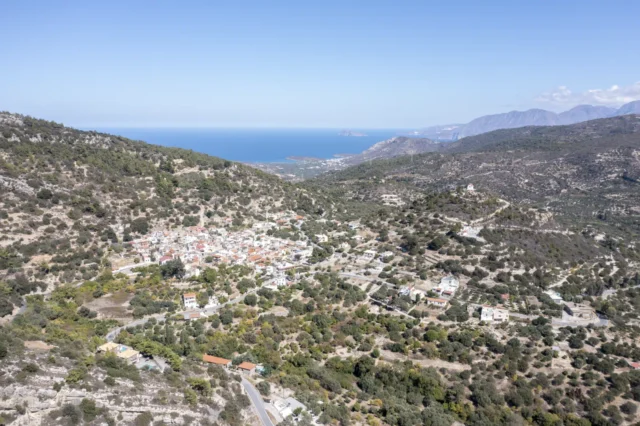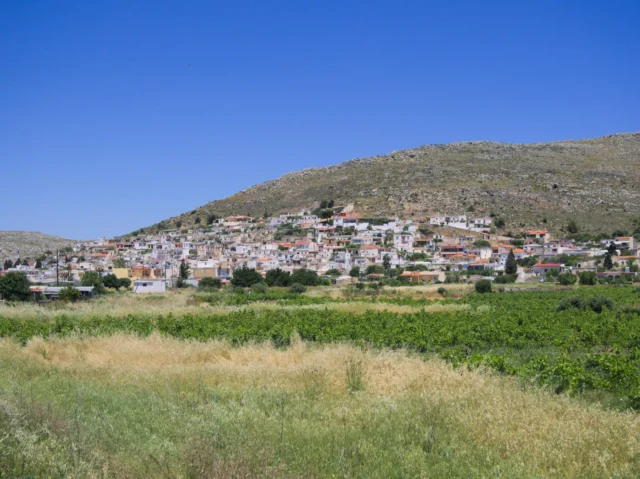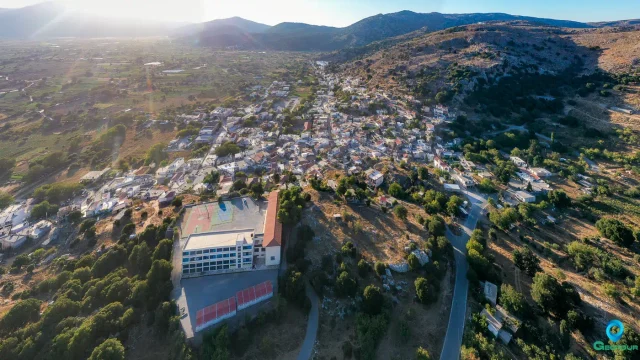135
listings found
Categories
Active filters:
Meseleroi, Ierapetra
Meseleroi is a settlement located in the Lasithi regional unit on the island of Crete, Greece. It belongs to the Municipality of Ierapetra
Goudouras, Siteia
Goudouras, a coastal settlement in southeastern Crete, is a fishing village known for its location on the Libyan Sea. It consists of Asprolithos and Goudouras, named after Cape Goudouras (ancient Erythraion) and the plant agouduros. The area has a long history, with population growth due to internal migration. Today, it's a tourist destination known for beaches, fresh seafood, and a quiet atmosphere, even with mild tourist development. The stone church of the Ascension sits near the exit of the Agios Antonios and Goudouras gorges. Nearby Agia Triada, Ziros, and Xerokambos offer additional exploration. The region's warm climate supports olive and vegetable cultivation, though greenhouses have altered the landscape.
Vasiliki, Ierapetra
Vasiliki, a village in Ierapetra, Lasithi, Crete, is known for its significant Minoan settlement dating from the Early Minoan II to the Late Minoan I periods (2600-1550 BC). The settlement, located on Kastelli hill, prospered due to its location on the Ierapetra isthmus and the surrounding fertile plain, near Gournia. Excavations by Harriet Boyd, Richard Seager, and Antonis Zois revealed Vasiliki-style pottery and confirmed Mycenaean fortification and aqueduct presence. The village's history includes mentions in the 1671 Turkish census, the 1834 Egyptian census, and subsequent population records. The settlement's central building was destroyed by fire around 2300 BC, but later reoccupation occurred, with Roman-era traces also found.
Pacheia Ammos, Ierapetra
Pachia Ammos, a coastal village in Lasithi, Crete, is situated near the archaeological sites of ancient Minoa and Gournia. The village, mentioned by Basilicata in 1630, developed in the 20th century, becoming a tourist center. It boasts a long beach, taverns, and the Institute for the Study of Prehistoric Aegean Eastern Crete. The village's name, meaning "thick sand," reflects its beach. Pachia Ammos is served by bus routes connecting it to nearby cities and has a rural medical center, schools, and various shops. The area's history includes the Minoan civilization, with Gournia being a significant site. The current population is around 574 inhabitants.
Oreino, Ierapetra
Oreino, or Orno, is a mountain village in Ierapetra, eastern Crete, at 620m altitude on Mount Afentis. First mentioned in 1368, it's known for the 5km long Oreino Gorge with the Byzantine Transfiguration of the Savior church. The village, once on Kastri peak, is now verdant with pine trees near Lake Skafi and the Red Butterfly Gorge. The gorge's name comes from its red butterfly population, impacted by a 1993 fire. Oreino is accessible from Ierapetra and offers traditional Cretan cuisine at the "Orno" tavern. The settlement's history includes Venetian and Ottoman rule, reflected in its architecture and cultural heritage.
Chandras, Siteia
Chandras, a village in the Siteia municipality of Lasithi, Crete, sits at 580 meters above sea level on the Armenohandrades plateau. Likely founded during Arab rule, its name may derive from the Arabic word for "green". The village was recorded in a 1577 census as Ghandra and in a 1583 census as Candra with 403 inhabitants.
The old village center, "Mesochoria", houses the churches of Agios Dimitrios and the Assumption of the Virgin Mary. Remnants of an Ottoman hammam can be found there, along with a Renaissance fountain and Venetian-influenced buildings. A folklore museum is also present in the village. The church of Agios Haralambos, with its neoclassical bell tower, stands in the northern part of the settlement. Nearby, the abandoned medieval village of Voila preserves monuments from the Venetian and Ottoman periods.
Armenoi, Siteia
Armenoi, a village in eastern Crete's Sitia municipality, is located on the Armenohandrades plateau. Historically inhabited since at least 961, it's known for its Byzantine churches, including Koimisis tis Theotokou with 1570 frescoes by M. Kornaros, and Agios Georgios. The Monastery of Agia Sofia, dating to Venetian times and renovated in the 19th century, also resides nearby. The village's history includes Venetian and Turkish rule, an 1856 earthquake, and population fluctuations.
Lithines, Ierapetra
Lithines, a historic Cretan village in Siteia, is known for its Byzantine and Venetian heritage. The village, possibly named after the Litino family, features the 10th-century Church of the Virgin Mary with 13th-14th-century frescoes and the miraculous icon "Our Lady of Lithines". The pre-15th century Agios Athanasios church houses the Vlachos family tomb. The Byzantine Holy Apostles church at Adromili has 14th-century frescoes. A Venetian tower, destroyed in 1828, once stood in the village center. Lithines' architecture reflects the 17th-19th centuries, earning it historical monument status. The village has an agricultural cooperative producing olive oil and a cultural center in the renovated old school building. The population in 2011 was 322.
Sfaka, Siteia
Sfaka, a village in Lasithi, Crete, is located between Siteia and Agios Nikolaos. Its name originates from the "sfakes" (bitter oleanders) near a spring. First mentioned in Venetian censuses, Sfaka has a rich history, including a Minoan tomb and a 17th-century church. The village is divided into upper and lower sections by the main road. Agios Andreas, a coastal settlement within Sfaka, offers tourist accommodations. Gennadios Syllignakis, a local resistance figure, was executed by the Germans during WWII. The village also has a primary school and a kindergarten.
Prina, Agios Nikolaos
Prina is a settlement located in the Lasithi regional unit on the island of Crete, Greece. It belongs to the Municipality of Agios Nikolaos
Schinokapsala, Ierapetra
Schinokapsala, a village in eastern Crete, sits on Mount Thrypti's southern slopes, overlooking the Libyan Sea. Its history includes Minoan presence, Venetian records dating to 1577, and Ottoman-era habitation. The village, mentioned in Venetian censuses, was repopulated by farmers. Agios Georgios church features frescoes. Near Achlia, Mavros Kolympos, and Galini beaches, Schinokapsala combines mountain scenery with coastal access.
Exo Apidi, Siteia
Exo Apidi, near Siteia, Crete, has a rich history dating back to antiquity. Ancient cities like Lenika, Keratos, Erythrai, and Stilai thrived there, known for the production of porphyra, a valuable purple dye. The oldest settlement is Droggari. During the Turkish occupation, villagers resisted, and during WWII, they aided British and Cypriot refugees. The area's mountainous terrain led to resistance against Turkish rule. Piracy fears led residents to live in the mountains, using watch points like Vigla. Numerous caves, including Katochigi, served as hiding places. The village's population has fluctuated over the years.
Ziros, Siteia
Ziros is a village in eastern Crete, built at 590 meters on the southern foothills of Mount “Engremnos”. The area is characterized by limestone rocks with karst formations such as sinkholes and caves.
The area of Ziros is rich in archaeological remains. Near the village of Chamaitoulo, at the site of Vrysi, a large Minoan settlement with cyclopean walls has been found.
The earliest written mention of the settlement is made by Francesco Barozzi in 1577, who refers to it as Siro. In the Venetian census of 1583 it is referred to as Ziro with 448 inhabitants.
In the village are the churches of Agios Nikolaos, Agios Georgios, and Agia Paraskevi. The church of Agia Paraskevi has frescoes dating back to 1523.
Neapoli, Agios Nikolaos
Neapoli is a settlement located in the Lasithi regional unit on the island of Crete, Greece. It belongs to the Municipality of Agios Nikolaos
Agios Nikolaos, Agios Nikolaos
Agios Nikolaos, a coastal town in Crete, sits on the ancient site of Lato pros Kamara, once the seaport of the Dorian city Lato Etera. In the 13th century, the Venetians built the Mirabello fortress there, which was later destroyed and rebuilt several times. Today, Agios Nikolaos is the capital of the Lasithi region and a popular tourist spot. Visitors can explore the ruins of the Venetian fortress, relax by Lake Voulismeni, and visit nearby attractions like Spinalonga, a fortified island with a fascinating history as a leper colony. The town also features beautiful parks, interesting sculptures, and charming squares.
Ierapetra, Ierapetra
Ierapetra (Ιεράπετρα) is a coastal city located on the southeastern coast of Crete, Greece. It is the largest town in the regional unit of Lasithi and the fourth largest in […]
Siteia, Siteia
Siteia, a coastal town in eastern Crete, boasts a rich history dating back to ancient Greece. Possibly the birthplace of Myson, one of the Seven Sages of Greece, Siteia's historical significance is evident in its landmarks like the Kazarma fortress, a Venetian-era structure, and remnants of an Early Christian church and Roman fish tanks. The Archaeological Museum houses artifacts spanning millennia, including a collection of vessels and Linear A tablets. Today, Siteia is a vibrant town with a mixed economy of agriculture, handicrafts, and tourism. Visitors can enjoy various beaches, including Siteia Beach and Vai Beach, and explore the local culture at the Folklore Museum and the Museum - Exhibition of local products. The town is easily accessible by road, air, and sea, with Siteia Airport offering connections to various destinations.
Tzermiado, Lasithi plateau
Tzermiado is a settlement located in the Lasithi regional unit on the island of Crete, Greece. It belongs to the Municipality of Lasithi plateau
Hellenistic Town of Ampelos in Xerokampos
An ancient Hellenistic city (4th-1st centuries BC) on Crete's southeastern coast at Xerokampos. Its urban plan focused on maritime trade, unlike typical inland cities. Its most unique feature is its dual urban centers: Pharmakokephalo, a fortified coastal hub (approx. 12,000 sq meters) with walls and towers for trade, and Kastri, an inland acropolis 1km away for civic and administrative functions. These two centers were interconnected and complementary, reflecting a complex social and economic organization. The site offers insights into Hellenistic settlement patterns and interactions with other centers like Itanos and Hierapytna.









